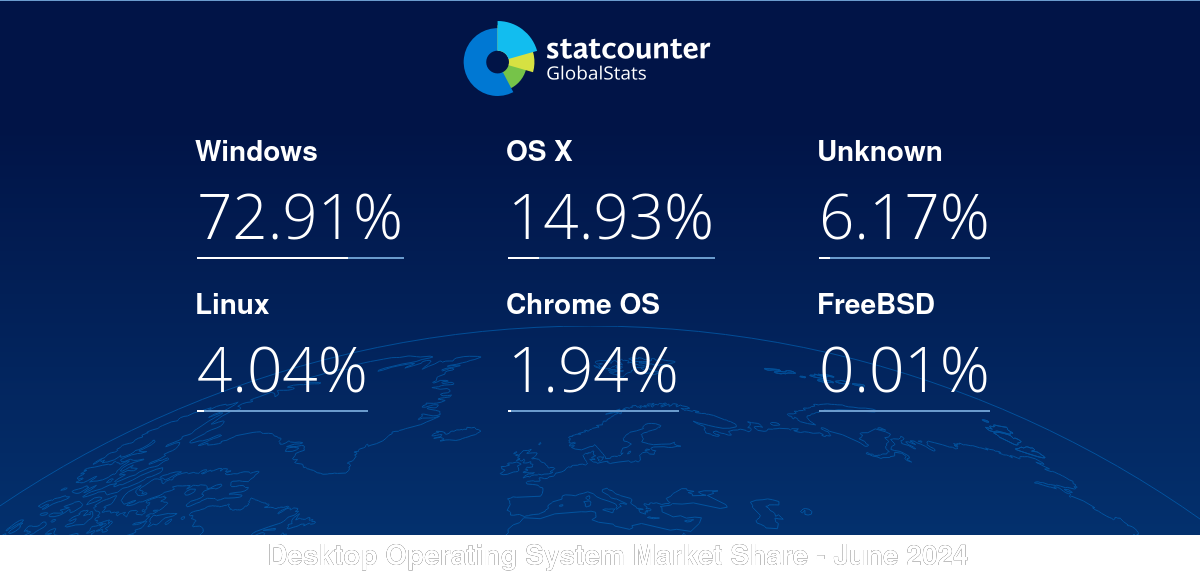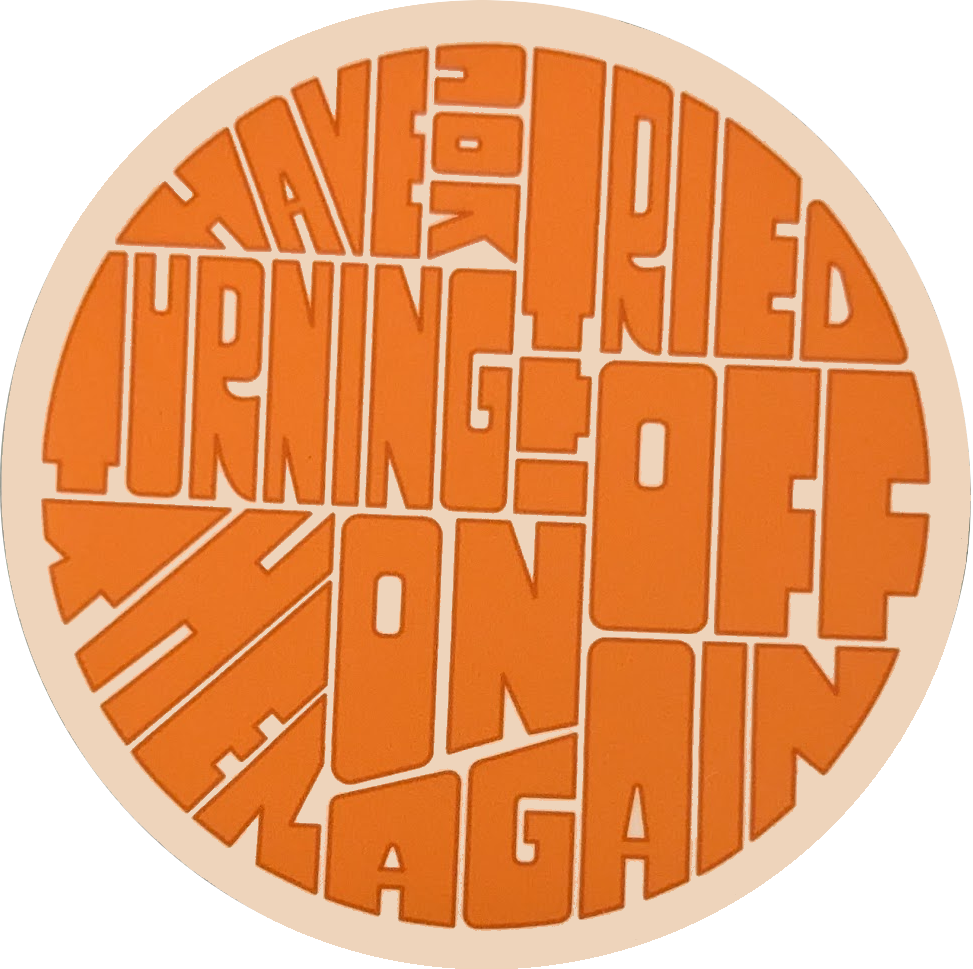It peaked at 4.05% in March. The last 2 months it went just below 4% as the Unknown category increased. For June the reverse happened, so 4.04% seems to be the real current share of Linux on Desktop as desktop clients were read properly/werent spoofed.
The combined forces of microsoft reaching new heights of greed and intrusion, plus the massive dev efforts for the best ever GNU Linux and Proton 📈📈📈
Microsoft set themselves up the bomb
Microsoft: As long as Adobe, Office, Autodesk are on my side, I have nothing to worry about.
I use Linux for personal use, and Ive been using windows for work due to necessity.
There is one app I need that does not support Linux. I contacted their support asking about a Linux version and they suggested using waysroid to run the android version of the app.
So, when I have free time I’m working on switching things over.
My main motivation is Microsoft pushing ads everywhere and being aggressive about using online accounts and stuff that like.
Whats interesting is that both income , profits and the stock have been growing well for years, maybe they are just monetizing more aggressively because they can’t compete on product quality (unlike other markets that are still evolving, AI and Cloud). not a ton of stuff to improve in operation systems it seems.
There are system dialogs that have unused space for ads, still plenty to improve!
In all seriousness, cloud (azure) and office subscriptions blew up and account for like 70% of MS profits. They know the Windows experience is lacking, but when they already capture so much of the market and it’s such a small slice of revenue, they have no incentive to improve.
dont forget soystemd and wayland
i don’t have a strong opinion on systemd, i just heard someone call it soystemd in some YouTube video once and it just stuck in my head for years
In all seriousness, I think government bodies switching to Linux (UK’s, China’s, some Indian states’) attributes the most to this.
No I think it’s the Steam Deck. It’s like half of all actively used Linux machines.
Half of the Linux machines on Steam, not the entirety of Linux.
Yes sorry you’re right
no, the statistics are based on browser agents, very few steam deck users browse the Internet on their devices. it’s also only half the Linux devices on steam, not of all Linux desktops
But that’s not really a Desktop is it? If we’d count mobile device we’d also have to include Android and then the situation would look completely different.
Steam deck has a full fat kde desktop on the stock os
I could install a full fat kde on the entertainment system of a car - still wouldn’t call it a desktop PC.
You can plug in a keyboard, mouse, and monitor
We don’t include Android here. What I meant is that the Steam Deck does count in that statistics.
Connect the Steam Deck to a compatible dock and you can quite easily use it as a desktop. At the end of the day, it’s still an x64 based PC that’s just handheld.
I’m not sure that’s really a good argument. I can connect an android smartphone to a monitor, keyboard and mouse and call it Desktop. It’s also just an arm64 or x64 based PC just handheld.
A Desktop PC IMHO is a device that is used for everyday “office” work and neither android smartphones nor steamdecks are that - but laptops for example are (IMHO)
Steam Deck is a desktop. It is exactly the same PC hardware and software you are using on your desktop PC. It runs the same games and is software compatible. Steam Deck is a desktop PC.
Android has a different hardware (not x86 compatible), is focused on phones, its eco system of software is not compatible with PC and in reverse does not run your PC software. Android based smartphones are not a PC.
But how many use it for browsing, which I imagine this data is from?
Valid point to be honest, but the answer is probably more than you think. I have a PC and still used the Steam Deck to browse the web too, not at least to install stuff. Also searching something while playing is useful too. Its made to be docked to bigger screen as well.
While you are probably right, my point was its still a PC, because he compared it to Android. And why this is hugely different. His point was to exclude Steam Deck, because it is not a PC, just like we would exclude Android. This data from the stats probably does not make a difference if its a Steam Deck or not (nor can it tell it? because browsing is the same as on PC, its an Archlinux and regular browser after all). On the other side it can definitely tell if its Android and exclude it.
So regardless if you think people browse the web with Steam Deck or not, this data should not be able to tell the difference between most distributions and Steam Deck, as its just a normal PC with Firefox (or other web browser) from the point of the stats. Just my assumption.
So your definition for “desktop” is if it’s an x86 compatible architecture? Seems pretty random to me. Btw, there are x86 android device. IMO a desktop is something on the top of a desk to do typical “office work”. PCs, Macs, Laptops, etc. but calling a SteamDeck game console “Desktop” is pretty dishonest I think.
PC in the first place means x86 architecture. Desktop is the operating system, here a Linux desktop or Windows OS. Nothing random here. Steam Deck is a Desktop PC with form factor of a handheld. Just like any other Laptop is a Desktop PC in a notebook form factor. It runs, plays and uses the exact same hard and software as a Desktop PC. Calling Steam Deck PC not to be a Desktop is pretty dishonest. Also saying desktop PC must be on a desk for typical office work is random too.
Also this is all about stats. Don’t forget, this is not your opinion or my opinion. I am speaking from the stats perspective, as the Firefox browser (or any other browser) is just a Desktop PC from the perspective of the stats.
If you say I am pretty random and being dishonest, then first, you are discounting others opinions, secondly did not even understand the purpose of my reply. Maybe you should watch out your language next time before responding if you want further discussion. I hope my reply here made it crystal clear.
The names are pretty clear and are about form factor. Desktop is something on top of a desk. Laptop is something on top of your lap. Hand-held is something you hold in your hand.
The steam deck is a hand-held game console - doesn’t matter what OS is it uses. It’s true that most stat tracking sites count it as “desktop” but not because it’s a desktop computer but because the user agent looks similar to desktop user agents.
If I install Android on a tower PC it doesn’t randomly become a smartphone even though all browser trackers would register it as a smartphone.
And Valve using a “typical desktop OS” on their handheld console doesn’t magically turn it into a desktop PC.
The example with Android makes no sense as a argument in our discussion.
The steam deck is a hand-held game console - doesn’t matter what OS is it uses
Wrong. It does matter. Plus, it matters what software and what configuration it uses the moment it gets counted in the stats.
The discussion is not about what you try to tell. You can say what you want, it does not matter that the Steam Deck uses hardware that is PC and software that is a hybrid of Desktop and Gaming operating system. And when going to the web with a web browser, then the Steam Deck is in Desktop mode, and therefore seen as a Desktop PC. Not only act it like that, the functionality is a Desktop PC.
The Steam Deck has two modes if you forgot that, and we are talking about the Desktop PC mode. Which is what the stats are all about.
It is. I use it as such regularly. Keyboard+mouse+screen = browsing firefox as usual. Works quite well. Libreoffice, okular, signal desktop… I’ve used worse computers in recent years, steamdeck desktop experience is better than many 4 to 5 year old cheap laptops with win10 or win11.
In Steam maybe. But this is StatCounter which is website visits. I doubt many Deck users are browsing the web.
For some reason I think a lot of them (probably even more than half) have tried browsing the web or at least using the desktop mode at least once.
Oh that is a good point, why didn’t I think of that!
The youtuber matt from thelinuxcast sucks.
I am regular user, i don’t code for living and my job is not tech related. I wanted to try linux and many of you guys supported and now I’m using Linux since 2 weeks its linux mint. That matt guy was so against linux mint that i thought it was shit too. But when i installed and started using it. It has been a smooth journey. Many people in linux community were helpful. But people like matt really make it for us regular guys scared to use linux. I really hope many good linux user help regular people switch to linux and increase this number.
Mint is great and is absolutely enough for most people using computers, still as of now. It comes with its limitations though:
- By default it runs pretty old kernel. This is fine if your hardware is at least 3 years old. It allows to easily switch to newer kernel with just few clicks, but I expect newbies to not be aware of this at all. Oh, and I don’t know if it offers some custom kernels like tkg etc, which some might want to squeeze best gaming perf etc.
- Cinnamon is still limited to X11. If you have multi-screen setup, VRR, mixed refresh, mixed DPI etc, it’s better to switch to Wayland. Plus, Xorg server gets less and less maintenance and development. All the innovation moved to Wayland, so the experience on X will remain pretty stale.
- The Ubuntu base makes it so that for 3rd party software you either need deb packages or PPAs. Some will argue (me included) that it’s not the best solution
All of the above can easily be irrelevant to you and Mint is just perfect for what you need. It’s important to point out limitations of that choice, but crapping on it because you don’t like it is just pointless fuss
On your last point, there’s also Flatpak which is available right from the baked in software center… That’s not without its issues too, but they’ve been an overall smooth experience for me so far
Yes, Flatpak fixed a lot of the old shenanigans we used to have when everything was either native package, or a binary to hope for the best and install libraries manually, or source code to collect everything that’s needed for building and again, hope for the best. It is however designed to provide a way to install graphical apps, but can’t handle everything native package does (like out-of-tree kernel modules, CLI utils, system services)
I believe it can do CLI, but that’s not always been the case and not a lot of CLI apps adopted it as a result
But for most of what the typical user, or even a lot of what a technical user, needs, it does a good job
Cinnamon can run Wayland in experimental mode. It’s just an extra click during login. Mint also has direct support for flatpaks repositories, with flathub by default directly on the software center.
Any experience you can share on how complete and stable is that experimental session? I probably wouldn’t throw newbie on that
There’s a bug where flatpaks seemingly disappear from the system the first time you run Wayland. But it resolves with a reboot. It happens too if you change back from Wayland to X11. Other than some minor glitches from very old software that hasn’t seen an update in decades, it runs perfectly fine.
I get what you mean. I see a decent chunk of often more tech-proficient Linux users putting down Linux Mint, and it saddens me because even though I don’t use Mint anymore, it was still the first distro I properly daily-drove and I still consider it an amazing system for people who are new to Linux.
I’m very glad you’ve been having a good experience with Mint!
I don’t get them putting Mint down either, and I’ve built multiple Gentoo systems… I don’t need an easy distro but still use Mint and like it for what it brings (basically, it’s Green Ubuntu, what Ubuntu was supposed to be before they lost their way)
This is an interesting post. I know the YouTuber you are talking about. I do not really like him but I would have considered him harmless. It is interesting to get your take.
Mint is great and quite popular. So, if you are going to make a YouTube video saying otherwise, I guess you have to go out of your way to come up with reasons why. I am sure that makes it sound worse than it is. Something to think about.
I have distro preferences too but most of the differences really only make a difference to those already using Linux. It is a bit like arguing about Ford vs Chevy in front of people that have never seen a car ( or truck ). In the grand scheme, they are both amazing and mostly the same thing. To listen to a fan though, one is God’s gift and the other is trash. Same with Linux distros.
Can we commit to only posting about round number percent changes?
What’s interesting is that multiple trackers are now saying it’s above 4 percent. Last time something was posted, people questioned the data and where they got their data (which they should). Now there’s multiple sites showing a real increase.
No, we have to post these when it’s the year of the Linux desktop
Windows 11: Add advertisement to the start menu, add remote Artificial intelligence to your daily live. Require new CPUs and motherboards / hardware, ignoring the market for old computers.
What will they do next?
- More advertisement.
- More features that require an always on internet connection?
- Forced restart for software updates
This is why I expect Linux share to slowly increase until the old computers die and you will not be allowed to choose to boot another operating system besides Windows on your Microsoft-Copilot+ PC that would be your only option.
Next:
-
Must always be online
-
Cost is now $9.99 per month (free with commercial breaks. For now of course.)
-
Everything is stored online (60GB free, $5.99/month to up it to 199GB, $49/m for 400GB).
-
Windows decline has nothing to do with any of the actual features.
It is declining because fewer people are buying PCs anymore. Every one is using a mobile device or tablet.
This is also the reason they are squeezing windows harder to make up for the down turn.
This is clearly a statistic about PCs, otherwise the share wouldnt be ~73% windows. So the decline of the desktop PC doesnt really matter here
The people who are more likely to retain a PC and not just use a phone, are more likely to be tech literate power users.
This selects against casual windows users, and selects for hardcore Linux users
But we’re talking about proportions of Desktop operating systems. People using the desktop less might decrease (or slow the increase) of total desktop usage; but there would need to be more reason that just that for it to impact Windows disproportionately.
My brother, who want nothing to do with computers if he can, asked me to install Linux on his domestic laptop. It’s not an everyone is doing it yet, but there’s definitely something.
Forcing everyone to stay connected will make pirating it harder, and that will drive many, many people away.
I have had to do some work on my windows pc and I hate it. I have been away from desktop for a while now and changed to linux for personal one. At work it is all G suite, which does work to its credit, but the windows OS and microsoft cloud documents suck so much. The look and feel is clunky, so clunky. Constantly refreshing and just being shit.
Never forgive forcing outlook.
I work in email Marketing and Outlook is the worst client, especially desktop. Everything I make has to have accommodations for this shitty inbox
And as a user do I hate it too. It is too many times while I edit an email and click delete that is deletes the email instead… It seems if I click a word and get the spell window does the focus always change to the list of emails… And it also force a spell correction if I click space… I didn’t pick one of the options I just want to edit the word myself!!! And if I scrolldown to remove some parts of the email thread or just want to copy a part won’t it let me if I don’t click twice… and it jumps around…damn I hate it so much. Sorry that I replied to you with all these anger. But I really felt it when I saw yours and ops comment. I hope we one day will at least think it is an ok client to work with
All the different versions as well. Outlook web is decent, desktop is terrible. The Mac version seems to be closer to web, some problems I have are fine in one version of outlook and only appear in another. Why can’t the app just be a container for the web version?
As a service outlook (microsoft mail) sucks, as a web service their page sucks andnisnpoorly laid out and optimised and the new desktop client is atrocious.
They made me change from hotmail outlook, created a hotmail folder for under the new outlook and now I dont get notification for that address on the outlook app. If something gets marked as spam that isnt, marking it not spam sends it to the outlook inbox regardless of intended destination. If I reply to a mail it prioritises outlook despite the mail being sent to hotmail. As a result I cant log into shared files that people gave access to one but not the other.
I wonder what’s on the ‘unknown’
likely content blockers preventing the trackers from working properly and invalid user agents. So i would expect about the same ratio of usage on there as well. Maybe very slightly more Linux since maybe the users are more likely to tinker with their browser configs and install content blockers, but even there Id say its an extremely slim minority of even linux users who do that
StatCounter also sometimes miscounts when new versions of windows or macos come out. At one point (I think at windows 11 release) there was a huge dip in windows 10 users and a huge gain in “unknown” and it was quickly fixed.
Bare Metal, they are injecting Ethernet cable directly into their bloodstream.
That 6% attributed to “unknown” is the one true OS, the only one ordained by the Almighty… Temple OS!
True Temple OS has no networking
Based security approach
Amiga.
Netcat, mostly
Sorry, I stopped playing factorio on my work Linux computer. I will play next month to get us back up.
Don’t worry, I’ve been playing plenty of Linux factorio for the last few weeks to make up for it.
Thank you for your service
I am still hoping it will hit 10% market share within my life time. I remember when it was predicted to hit that in 2010, obviously it didn’t happen*. Of course for me personally, the year of the Linux Desktop was 2007 when I was finally able to use it as my main OS at home, I tried it before many times since 2003.
* not counting systems that use the Linux kernel but aren’t considered a traditional GNU+Linux desktop.
THE YEAR OF THE LINUX DESKTOP
I assume the proportions of people who spoof their OS is slanted towards Linux
why do we negate chromeos we are 10% at least so there we really are
deleted by creator
This is probably a good place to ask, but when ditching windows for Linux, what’s a good distro to go with? Preferably one that has a good WINE interface.
I’ve seen a lot of people move to Mint or Pop_OS or Kubuntu. They’re Debian based so updates are pretty stable.
I personally ended up with EndeavourOS using the KDE desktop environment. I have a steam deck, so this felt very similar to me. This is Arch based so sometimes updates break things, but I’ve had more success here.
Also remember that no distro is problem-free, but neither was Windows. The longer you commit, the easier it gets.
EDIT: If you’re hesitant to fully commit at first, I also recommend dual booting with Windows. Over time you’ll use it less and less until one day you feel like reclaiming the disk space.
If you’re hesitant to fully commit at first, I also recommend dual booting with Windows. Over time you’ll use it less and less until one day you feel like reclaiming the disk space.
I have a 10 year old laptop that I had to get rid of the hard drive for and am installing an nand drive and want to use to re-familiarize myself with Linux on it. Especially since my main desktops are too old to upgrade to Windows 11(not that I’d want to anyway) and I figure going Linux now will save me from scrambling when the pooch gets thoroughly screwed after Win 10 updates end.
I tried doing a dual boot to Mint awhile back, I did the mint backup at the start like it suggests, changed some things, broke it, restored from the backup thinking it was great id already made one, and broke the WHOLE pc.
I had to pull the battery on the BIOS to get it to go beyond a black screen when turning on.
It was terrible.
It seem to recall at the time recommendations about not doing dual boot, and if you wanted to dual boot, remove the main OS drive when you install Linux. Then put it back in.
I’d personally recommend Linux Mint Debian Edition. After distro hopping for a bit, it has personally been the best one for working right out of the box, both for my games and for my peripherals.
I like the UI, it’s about at my tech level/needs. I have little to no complaints about it, which is as good as it gets.
This is one of many comments I’ve seen on several posts that have recommended Mint. I’m currently playing around with Ubuntu, just because it’s the one I’m most familiar with from back in the day, but since the drive I’m using is temporary I might do a wipe and then load Mint and see how that operates.
In my experience, experience with one distro is experience with them all. 90% of what you are familiar with will be either similar or completely the same. So definitely give LMDE a shot.
OK, who did you guys bully over basic tech support questions?













